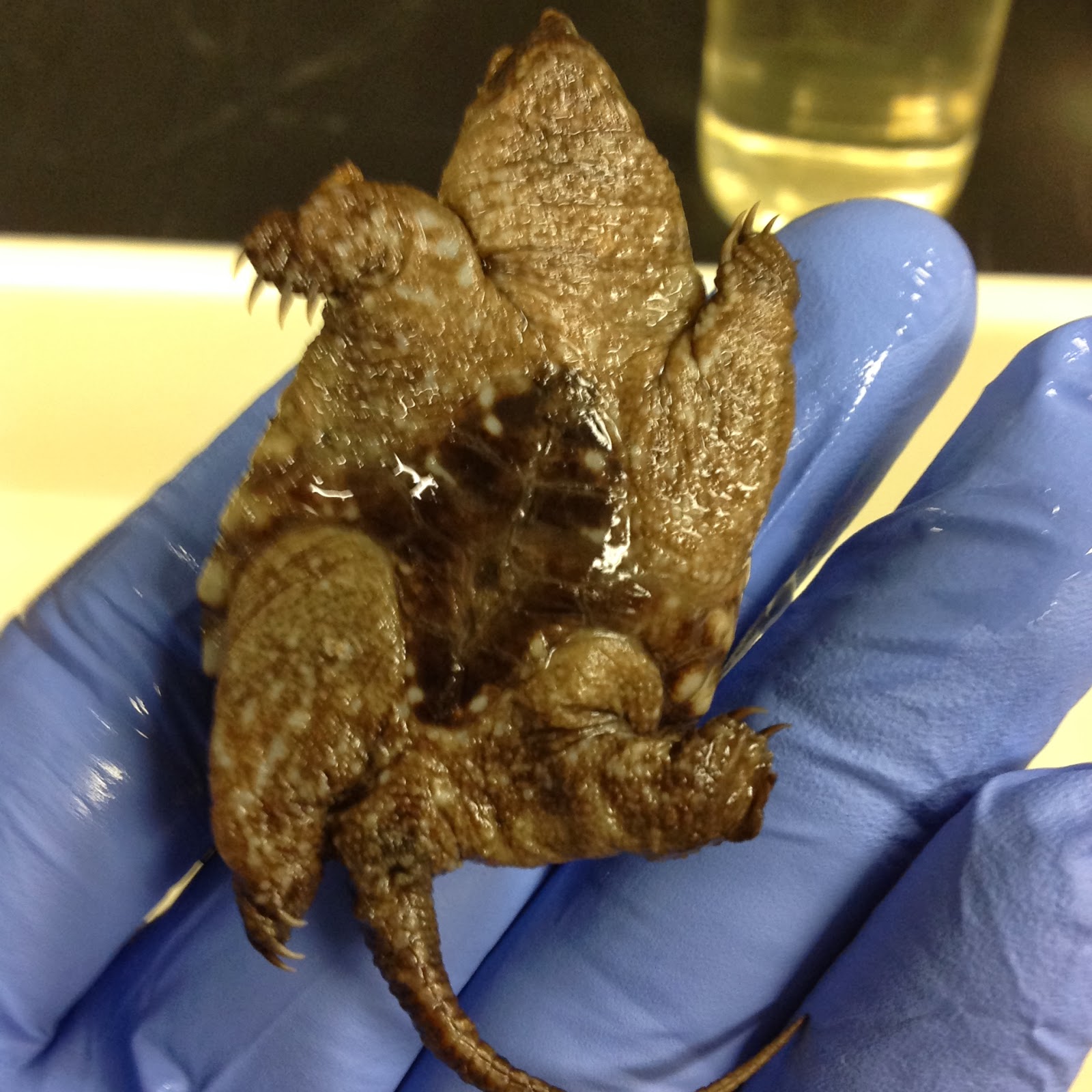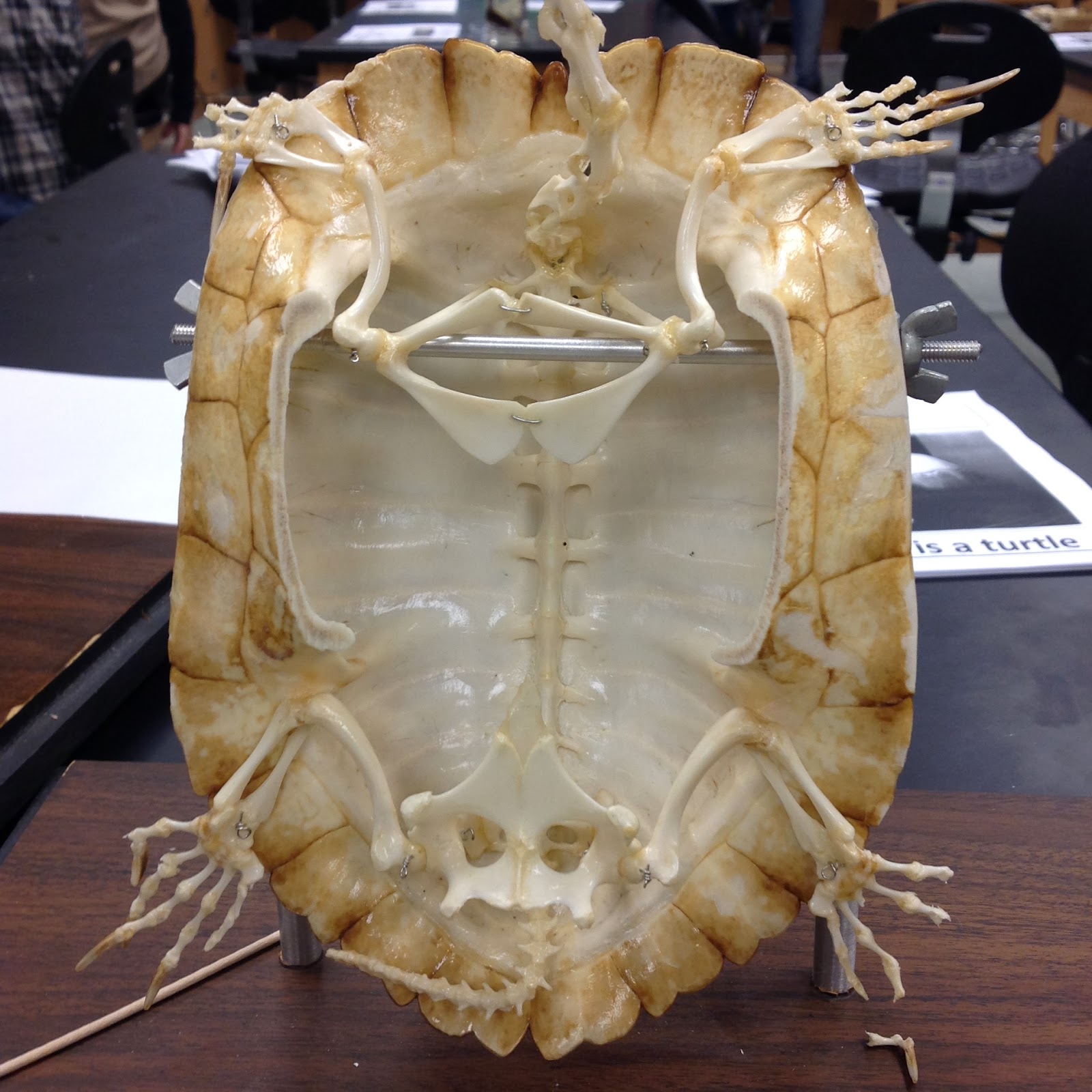Lab #2: Testudines
There are currently 327 identified extant species of Testudines, placed into 14 families. In this specific lab, 8 of these extant Testudines families were examined and described. The eight specific Testudine families that were examined in this lab are as follows:
- Podocnemidae (Madagascan Big-Headed Turtles & American Side-Neck Turtles)
- Chelidae (Australoamerican Side-Neck Turtles)
- Trionychidae (Soft-Shell Turtles)
- Cheloniidae (Hard-shelled Seaturtles)
- Chelydridae (Snapping Turtles)
- Kinosternidae (Mud and Musk Turtles)
- Testudinidae (Tortoises)
- Emydidae (Cooters, Sliders, American Box Turtles)
 |
| Figure 1: Phylogenetic Relationships of Turtle Families |
Pleurodira and Cryptodira Testudines
Within the Testudines, there is a basil split between Pleurodira and Cryptodira. The two following terms refer to how Testudines hide their heads when they are frightened. Pleurodiran turtles fold their head either to the right or to the left, and cannot pull their heads into their shells (Fig. 1)(Fig. 2). Cryptodiran turtles pull their heads into their shells within a pocket, during this process, the turtle's neck curves posteriorly in an "S" shape(Fig. 1)(Fig. 2).
 |
| Figure 2: Pleurodira vs. Cryptodira Neck Retraction |
1) Podocnemidae (Madagascan Big-Headed Turtles & American Side-Neck Turtles)
Location: Africa, Asia, New Guinea, SE Asia, Indonesia, North America
Characteristics:
Snorkel-like snout
Flattened "Pancake"
Reduced Carapace/Plastron
Lack epidermal scutes
Possess thick, leathery skin
Long Necks
Some Possess femoral flaps on plastron
Characteristics:
2 Genera, 2-5 Species
Large Heads (relative to body)
Skull roof deeply emarginated
Broad, flat Carapace
Reduced Plastron (cruciform)
Longest tail of any Testudine
Aquatic, only on lad to lay eggs
Opportunistic carnivores
Primarily Herbivores
Testudine Skull

The Arrow here point to the exposed cloaca, based off the position, this is a male Chelydra (common snapping turtle)
Chelydridae (Snapping Turtles):
Characteristics:
3 Genera, 8 Species
Moderately Large
River Turtles
Broad, domed, streamlined shells
Active Swimmers
Herbivores/Opportunistic carnivores
Nest in sand along river
2) Chelidae (Australoamerican Side-Neck Turtles)
Location: South America, Australia, Indonesia
(Southern Hemisphere only)
Characteristics:
Flattened Skull and Shell
Primarily Aquatic
Omnivores
Some leave water to forage during rains near water
(Gulp Feeding)
Six Cryptodira Testudine Families Examined in Lab:
1)Trionychidae (Soft-Shell Turtles)
Location: Africa, Asia, New Guinea, SE Asia, Indonesia, North America
Characteristics:
Snorkel-like snout
Flattened "Pancake"
Reduced Carapace/Plastron
Lack epidermal scutes
Possess thick, leathery skin
Long Necks
Some Possess femoral flaps on plastron
Characteristics:
Lattice-like plastron, either fused or separate, hyoplastron and hypoplastron
Opportunistic carnivores
Cutaneous Respiration (from not having scales)
2)Cheloniidae (Hard-shelled Seaturtles)
Location: Tropical to Subtropical Oceans
Characteristics:
Flat streamlined shells with epidermal scutes
Forelimbs flipper like
Hind limbs webbed for steering
Emerge on beaches only to nest
Require 25 years for sexual maturity
3)Chelydridae (Snapping Turtles)
Location: Eastern North America, Mexico & Central America, Northern South AmericaCharacteristics:
2 Genera, 2-5 Species
Large Heads (relative to body)
Skull roof deeply emarginated
Broad, flat Carapace
Reduced Plastron (cruciform)
Longest tail of any Testudine
Aquatic, only on lad to lay eggs
Opportunistic carnivores
Primarily Herbivores
**Two genera of Chelydridae are Chelydra (common snapping turtles) and Macrochelys Alligator Snapping Turtle**
- Biggest difference between the two species is that Macrochelys has four marginal scutes, whereas Chelydra
4)Kinosternidae (Mud and Musk Turtles)
Location: North America, Central America, and Northern South America (New World Only)
Characteristics:
24 + species
Smallest Testudines
Oblong, moderately domed carapace
Large heads compared to body size
Plastron commonly hinged
Reduced plastron
<10 epidermal marginal scutes
Entoplastron sometimes present
Generally aquatic
Bottom walkers
Hibernate on land
Can forage on land
Occupy underground retreats/nest communally
Occasionally nest below vegetation
5)Testudinidae (Tortoises)
Location: North/South America, Galapagos, Africa, Madagascar, Seychelles, Europe, Asia, Indonesia
Characteristics:
15 Genera, 45+ Species
Almost all have domed shells
Columnar/Elephantine feet
Terrestrial (Desert, Grassland, Scrub)
100 days incubation to 18 months
6)Emydidae (Cooters, Sliders, American Box Turtles)
**two Testudine subfamilies within this Testudine family, Emydinae (Fig. 3) and Deirochelinae (Fig. 4)
 |
| Figure 3: Subfamily: Emydinae, Genus: Clemmys |
 |
| Figure 4: Subfamily: Deirochelinae Genus: Graptemys |
Location: North America, Central America, Parts of South America, Europe, Asia, North Africa
Characteristics:
42 species
Medium Sized Turtles
Plastron large, occasionally hinged
Semi-aquatic/terrestrial
Sexual Dimorphism common (females 2X larger than males)
Omnivores or strongly herbivorous
Two Subfamilies:
1) Emydinae: conservative diets, diversity of habitats, some plastrons hinged
2) Deirochelinae: Diversity of diets, conservative habitats, aquatic, diet specialists, epipubes do not ossify
Testudine Anatomy
Skeletons of Testudines are the most
unique skeletons of any other type of reptile, because of the presence of a
sell structure. The shell structure is formed by two main skeletal
structures, the carapace and the plastron. The carapace (Fig. 5 & 6) is formed of
broadly expanded and fused ribs and vertebrae in the trunk region, as well as a
layer of dermal bones that span the spaces between these bones. The plastron (Fig. 5 & 6) is composed of
several paired bones that are remnants of the sternal elements and perhaps the
gastralia. Positioned within the shell structure are the pectoral girdle
and forelimb, and the pelvic girdle and hind limb.
Bones of the Carapace: (Fig. 5 & 6) Bones of the Plastron: (Fig. 5 & 6)
Nuchal
Epiplastron
Peripheral
Endoplastron
Neural
Hyoplastron
Costal
Mesoplastron
Suprapygal
Hypoplastron
Pygal
Xiphilplastron
 |
| Figure 5: Bones of Carapace and Plastron |
 |
| Figure 6: Bones of Carapace and Plastron examined in Lab 2: Testudines |
Overlaying the bony skeleton of Testudines
is a thin layer of epidermis. This epidermis produced large plate-like
scale, referred to as scutes (Fig. 7 & 8).
Scutes of the Carapace (Fig. 7 & 8): Scutes of the Plastron (Fig. 7 & 8):
Cervical Intergular
Marginal Gular
Supramarginal Axillary
Vertebral Humeral
Pleural Pectoral
Abdominal
Inframarginal
Inguinal
Femoral
Anal
 |
| Figure 7: Scutes of the Carapace and Plastron |
 |
| Figure 8: Scutes of the Carapace and Plastron examined in Lab 2: Testudine |
Girdle of Testudine
 |
| Figure 9: Pelvic Girdle of Testudine |
 |
| Figure 10: Pectoral Girdle of Testudine |

Testudines have the skull condition known as an Anapsid skull (Fig. 11 &12). Although Testudines demonstrate the Anapsid skull condition, many Testudine species have a deep temporal emargination on the posterior margin of the skull.
 |
| Figure 11: Anatomy of Testudine Skulls examined in Lab 2: Testudines |
Reproduction
Exhibit internal fertilization
Direct Development of embryos inside a cleidoic egg
Shell is hard or pliable and composed of calcium carbonate shell units
All are Oviparous
Males
1.Typically have a concave or slightly concave plastron to prevent them from sliding off females (Fig. 13)
2. Males typically have longer forelimb claws (Fig. 14)
3. Males have a very large copulatory organ, the intromittent organ, its purpose is like a penis to transfer sperm (Fig. 15)
A good way to tell difference between male and female Testudines is by examining the tail. Males tales will be fatter and more robust than the females, and when the tail is gently straightened, the cloaca will be exposed, clearly behind the posterior edge of the carapace, while the female cloaca is positioned at or before the posterior edge of the carapace (Fig. 16).
 |
| Figure 13: Comparison of Male Testudine and Female Testudine Carapaces |
 |
| Figure 14: Presence of Longer Forelimbs on Male Testudines |
 |
| Figure 15: Presence of Intromittent Organ in Testudines |
 |
| Figure 16: Male Chelydra (Visual of Cloaca Posterior to Carapace) |
Ohio Diversity of Testudines
Chelydridae (Snapping Turtles):
Chelydra serpentina (Common Snapping Turtle)
Kinosternidae (Mud & Musk Turtles):
Sternotherus odoratus (Stinkpot Turtle)
Trionychidae (Soft-Shell Turtles):
Apalone spinifera (Spiny
Softshell Turtle)
Apalone mutica (Smooth
Softshell Turtle)
Emydidae (Cooters, Sliders, American
Box Turtles & Allies):
Chrysemys picta marginata (Midland Painted Turtle)
Clemmys guttata (Spotted
Turtle)
Emydoidea blandingii (Blanding’s Turtle)
Graptemys geographica (Map Turtle)
Graptemys pseudogeographica (False Map Turtle)
Pseudemys concinna (Hieroglyphica River Cooter)
Terrapene carolina (Eastern Box
Turtle)
Trachemys scripta (Red-Eared
Slider)
























Figure 2: Pleurodira vs. Cryptodira Neck Retraction, good image
ReplyDeletefrom www.testudines.org
Delete